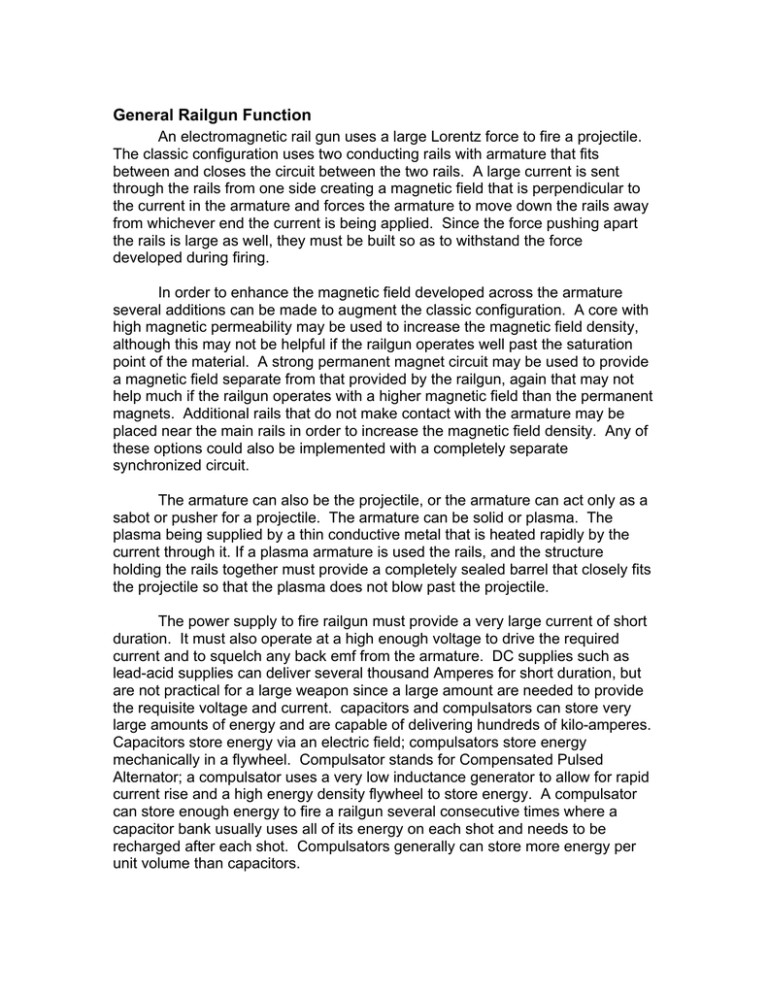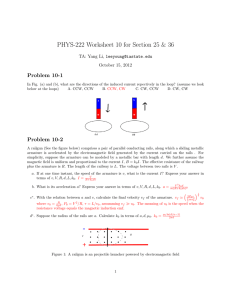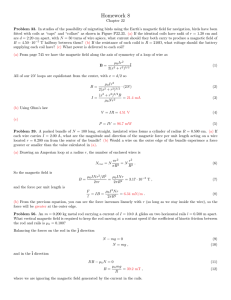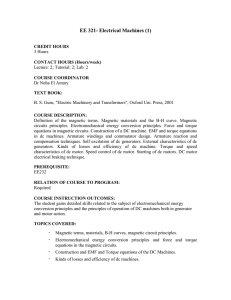as a PDF
advertisement

General Railgun Function An electromagnetic rail gun uses a large Lorentz force to fire a projectile. The classic configuration uses two conducting rails with armature that fits between and closes the circuit between the two rails. A large current is sent through the rails from one side creating a magnetic field that is perpendicular to the current in the armature and forces the armature to move down the rails away from whichever end the current is being applied. Since the force pushing apart the rails is large as well, they must be built so as to withstand the force developed during firing. In order to enhance the magnetic field developed across the armature several additions can be made to augment the classic configuration. A core with high magnetic permeability may be used to increase the magnetic field density, although this may not be helpful if the railgun operates well past the saturation point of the material. A strong permanent magnet circuit may be used to provide a magnetic field separate from that provided by the railgun, again that may not help much if the railgun operates with a higher magnetic field than the permanent magnets. Additional rails that do not make contact with the armature may be placed near the main rails in order to increase the magnetic field density. Any of these options could also be implemented with a completely separate synchronized circuit. The armature can also be the projectile, or the armature can act only as a sabot or pusher for a projectile. The armature can be solid or plasma. The plasma being supplied by a thin conductive metal that is heated rapidly by the current through it. If a plasma armature is used the rails, and the structure holding the rails together must provide a completely sealed barrel that closely fits the projectile so that the plasma does not blow past the projectile. The power supply to fire railgun must provide a very large current of short duration. It must also operate at a high enough voltage to drive the required current and to squelch any back emf from the armature. DC supplies such as lead-acid supplies can deliver several thousand Amperes for short duration, but are not practical for a large weapon since a large amount are needed to provide the requisite voltage and current. capacitors and compulsators can store very large amounts of energy and are capable of delivering hundreds of kilo-amperes. Capacitors store energy via an electric field; compulsators store energy mechanically in a flywheel. Compulsator stands for Compensated Pulsed Alternator; a compulsator uses a very low inductance generator to allow for rapid current rise and a high energy density flywheel to store energy. A compulsator can store enough energy to fire a railgun several consecutive times where a capacitor bank usually uses all of its energy on each shot and needs to be recharged after each shot. Compulsators generally can store more energy per unit volume than capacitors. For any railgun the currents required will place large amounts of mechanical stress on the current carrying parts. The rails current carrying bars and connectors must be stiff and fastened into place. If the railgun uses a plasma armature the armature/projectile will need to fit tightly into the barrel and the barrel will need to be sealed to keep the plasma from escaping. For a solid armature the surface area in contact with the rails will need to be maximized and good contact maintained, this is necessary to reduce arcing, spot welding and to allow for high current flow. The armature rail interface should be designed to minimize gouging, and if any gouging is to occur it is clearly more desirable to have the damage on the armature instead of the rails. So the rails should be as hard as feasible and the armature as soft as possible. Many materials and construction techniques have been tried to make long lasting rails. This is still an area of significant research. When the railgun is fired the armature/projectile should be injected at a high velocity to overcome that static friction of the barrel and to prevent spot welding. A fast injection also will spread out the heat generated across a greater area again helping to prolong rail life. Unless the magnetic field is supplied externally the armature should have a sufficient length of current carrying rail behind before it contacts the rails it in order to allow strong a magnetic field to be created. Even so it may be desirable to augment the magnetic field where the armature first makes contact since the current will not immediately begin to accelerate the armature. Railgun Force and Magnetic Field Analysis The general Lorentz force law describes the force on a moving charge in magnetic and electric fields. (1) r r r F = q⋅ E + q⋅v× B [1 pg 28] where is the force acting on q [N/C] r E is the electric field intensity [N/m] r B is the magnetic field intensity [T] v is the charge velocity [m/s] q is the charge [C] In a rail gun the moving charge consist of a large electric current in a conducting armature, the force to accelerate the projectile is given by the second term in (1). Since current is defined as a movement of charge per second, a current over a length l is equivalent to charge movement at a given velocity. (2) ⎡ m ⎤ ⎡C ⎤ q[C ] ⋅ v ⎢ ⎥ = i ⎢ ⎥ ⋅ l [m] ⎣s⎦ ⎣s⎦ (3) r r r F = q ⋅v× B = i ⋅l × B Expressing the cross product in (3) using the angle theta between the current and magnetic field gives (4) (4) r r F = i ⋅ l ⋅ B ⋅ sin (θ ) If the magnetic field is assumed to be perpendicular to the current then (4) reduces to (5) r F = i ⋅l ⋅ B Where B is the magnitude of the magnetic flux density. A rail gun can provide the current and magnetic flux using a conceptually simple circuit. FIGURE 1. The basic railgun concept, two parallel rails and a sliding armature. The current in the rails and armature creates the magnetic field indicated and a the desired force on the Projectile/Armature. For a given current the force along the armature varies along its length, and the magnetic field varies according to the length of the rails. The φ directed magnetic field of an infinitely long wire is (6) r r μi B = aφ 0 2πρ where μ 0 is the permeability constant ρ is the radial distance from the wire The contribution from a single very long, thin rail would be ½ that of an infinitely long wire (7) r r μi B = aφ 0 4πρ The rails that create the magnetic field may not be well approximated by assuming they are infinitely long. An expression for the magnetic field at a radial distance from the end of a wire can be found using the Biot-Savart law. (8) r r r μ0 ⋅ J × aR B(u1 , u 2 , u3 ) = ∫ dv' V 4πR 2 [1, pg 275] where r J is the current density [A/m2] R is the distance to the point of the contributed magnetic field if it is assumed that the cross section of the wire is negligible compared to the area to be integrated over then J dv' = i ⋅ dl and (8) reduces to (9) r r μ 0 ⋅ i ⋅ dl × a R B(u1 , u 2 , u3 ) = ∫ l 4πR 2 For the purposes of the following integration it assumed that the rails are very thin.The rails have length L, the magnetic field at a distance d from the end of one rail is then (10) r L μ ⋅ i ⋅ dl ⋅ sin (θ ) B(P ) = ∫ 0 0 4πR 2 the distance from a segment of wire to the point P can be expressed as (11) R = l2 + d2 the quantity sin (θ ) can be expressed as sin (θ ) = (12) d d = R l2 + d 2 the integral then becomes r L B (P ) = ∫ 0 (13) μ 0 ⋅ i ⋅ dl ⋅ d L l + d 2 = μ 0i ⋅ 2 4πd L2 + d 2 4π l 2 + d 2 2 When L becomes much greater than d the equation reduces to (7). Since the rails of a practical railgun cannot be infinitely long and a signifacant magnetic field is desireable it is useful to know how long the rails must be to reasonable approximate infinite rails. Expressing L as a multiple of d, L = x ⋅ d , setting d equal to 1 and dividing (13) by (7) gives a function describing the fraction of magnetic field compared to a wire of infinite length from the beginning of the rail. The fraction of magnetic field produced by finite length wires compared to infinite legnth wires as a function of the ratio x of wire length to the point where the magnetic field is measured. (14) x 1+ x2 The relation shows that when the wire three times longer than the distance to the point at which a given magnetic results, the field density is 95% of that of an ideal infinite wire. Equation (14) assumes a very thin wire, this is not the case in a rail gun, the dimensions of the projectile are of the same order of the rails carrying the current. However, this relation does give some idea of the length of rail necessary to set up a satisfactory magnetic field. FractionOfIdeal 1 0.8 0.6 0.4 0.2 Ratio 1 2 3 4 5 FIGURE 2. The fraction of an ideal magnetic field created by finite rails in terms of the wire length in multiples of the distance to the point the magnetic field is calculated. Assuming that the rails are constructed such that the magnetic field created closely approximates that of thin wires that extend to infinity, equations (5) and (7) can be combined into an expression for the force on the projectile in terms of current and length. The magnetic field contribution from the first wire being equivalent to equation (5) and given a rail separation of width w the expression of the magnetic field contribution from the second wire is (15) r r B = aφ μ 0i 4π ( w − ρ ) The total magnetic field at a point along the armature is then (16) r r ⎛ μ 0i μ 0i ⎞ ⎟⎟ + B = aφ ⎜⎜ 4 ( − ) 4 ( ) w π ρ π ρ ⎝ ⎠ Since the armature is in direct contact with the rails the magnetic field from the above equation would approach infinity at the points where the armature contacts the rails. So despite the fact (16) assumes a thin long wire the radius of that wire must be taken into account to prevent spurious results for magnetic field strength at the ends of the armature. Taking into account the radius R of the rails gives (17) r r ⎛ ⎞ μ 0i μ 0i ⎟⎟ + B = aφ ⎜⎜ ⎝ 4π ( R + w − ρ ) 4π ( R + ρ ) ⎠ Inserting (17) into (5), keeping in mind the current and magnetic field are perpendicular thought the armature gives the differential force (18) ⎛ μ0i μ 0i ⎞ μ 0i 2 dl ⎛ 1 1 ⎞ ⎟ ⎜⎜ ⎟⎟ = dF = i ⋅ dl ⋅ ⎜⎜ + + 4π ⎝ ( R + w − ρ ) ( R + ρ ) ⎟⎠ ⎝ 4π ( R + w − ρ ) 4π ( R + ρ ) ⎠ These equation show that the greatest force on the armature occurs at the point where the armature is closest to (touching) the rails. As the radius becomes smaller with respect the rail separation the disparity in force from the center of the armature compared the force at the ends of the armature becomes larger. Since the smallest force on the armature occurs at the center of the armature and largest force occurs at either end setting the distance rho in (18) to 0 and dividing by (18) with set to w/2 will give the ratio of force on the end of the armature to the force on the middle of the armature. (19) (2R + w)2 4 R ( R + w) Setting w in equation (19) equal to 1 allows for a graph of the force ratio as a function of wire radius in multiples of w. FIGURE 3. The force disparity between the ends and center of an armature as a function of the ratio between the rail radius and distance between rails. Integrating (18) over the the gap between rails gives an expression for the total force on the armature. (20) F =∫ w 0 μ0i 2 ⎛ μ0i 2 ⎛ R + w ⎞ 1 1 ⎞ ⎜ ⎟dρ = + ln⎜ ⎟ 4π ⎜⎝ ( R + w − ρ ) ( R + ρ ) ⎟⎠ 2π ⎝ R ⎠ Equation (20) describes the force exerted on the projectile a function of current, rail separation and rail radius. To get to this point I have assumed round wirelike rails of radius R, and I have assumed that the distance from the rails along rail separation w is large compared to the dimensions of the rail. The second assumption is clearly incorrect for points very close to rails, and if the rails are similar in size to the separation between them then the assumption is false at all points across the rail separation w. I have also assumed the rails are long enough such that the magnetic field across the armature is the same as if the rails stretched out from the projectile in infinite length. Figure 2 shows that this is a good approximation if the rails are several times longer than the rail separation. Another assumption is that the projectile is very thin. Yet another is uniform current density. In order to get a better equation for the force exerted on the projectile the BiotSavart law, equation (8) would need to be applied precisely to the rail forms. The average magnetic field across the armature would require integrating the equation across the rail separation w. Since the Biot-Savart law is a volume integral, the total equation would be quadruple integral. Doing this would eliminate the assumptions of half-infinite rail length, round rails, and the poor assumption that the points along w very far way from the rail compared to the dimensions of the rail. An analytical solution could be obtained for different types of rails, but a very complicated shape could result in an integral results in a long ugly result, or one that can only be solved numerically. Taking away the assumptions of uniform current density and a thin projectile pretty much forces one into finite element analysis and other numerical techniques to analyze railguns. However, despite its limitations equation (20) is useful. It gives approximate currents needed to produce a given force. More importantly it gives some pointers as to how to design a railgun. It shows that the force can be made much greater using magnetically permeable materials. In the range of currents and magnetic fields found in railguns, µ is not constant. It decreases significantly at very high fields, limiting the usefulness of permeable material. Another limiting factor of using permeable material is energy loss due to magnetization, and eddy current losses. Equation (20) also shows that the rail separation w should be maximized, although this value is set by the choice of caliber. The final important observation from the equation is that the rail radius R should be minimized. For rectangular rails this means they should not be very tall or wide compared to the barrel. This makes sense, since the current obviously needs to be concentrated near the barrel in order to created the largest magnetic field possible through the armature. The conclusions regarding rail separation and rail dimension have been confirmed by researchers using Finite-Element Methods [2]. Dividing the force of equation (20) by the iw will give an expression for the average magnetic field according to equation (5). (5) r F = i ⋅l ⋅ B Rearranging (5) and replacing l with w since w is the armature length in our equations gives (21) r μ i ⎛ R+ w⎞ F B= = 0 ln⎜ ⎟ i ⋅ w 2πw ⎝ R ⎠ Equation (20) and (21) allow for calculations to estimate the magnitude of currents and magnetic fields needed to fire a projectile from a simple railgun. Back EMF from railgun projectile. The voltage of course needs to be sufficient to drive the required current through whatever resistance the rails, armature and connections provide. Apart from this the voltage must also be large enough to overcome the back EMF from the projectile. (22) r r d r ∫ E ⋅ dl = − dt ∫ B ⋅ ds l S When the rails are relatively long the magnetic flux being created behind the projectile is constant and rate of change of area is the product of the armature length and its velocity. The line integral on the left hand side of (22) can be assumed to include the armature and differential area behind it, and the right hand side is simply the rate of flux change in the area behind the projectile. Equation (22) then becomes. (23) E = −B ⋅ v ⋅ w where B is the average magnetic flux density [T] v is the velocity of the armature [m/s] w is the armature width [m] E is the back EMF developed across the armature [V] The back EMF will oppose the established current, but given estimates of the expected magnetic field strength from (22), the expected velocity and the width of the armature a voltage source can be chosen so that the railgun can fire at the desired velocity. Mechanical Energy Storage and Compulsators. A compulsator stores its energy in a flywheel connected directly to the alternator. Assuming the flywheel is a solid homogeneous cylinder of material, it rotational inertia is I= 1 MR 2 2 The rotational kinetic energy is K= 1 2 Iω 2 the mass of the cylinder is M = ρlR 2π Combining these equations into an expression for kinetic energy gives 1 K = πρlR 4ω 2 4 Expressing this as energy stored per unit mass gives K= 1 2 2 Rω 4 This shows that a rotor of high speed and large radius is desirable in order to store the largest amount of energy possible. Depending upon the material chosen there is a limit as to how fast the rotor can be spun. Each material has a maximum peripheral velocity at which the centrifugal forces overcome the tensile strength of the material. The peripheral velocity is v=r . The maximum peripheral velocity is given by Vmax = Etensile ρ Since v=r . The maximum velocity equation can be inserted into the energy stored per unit mass to give a maximum energy stored per unit volume. K= 1 2 2 1 2 1 Etensile Rω = v = 4 4 4 ρ This shows that a high tensile strength to density ratio is desirable in an energy storage rotor material. REFERENCES [1] Johnk, Carl T.A.. “Engineering Electromagnetic Fields and Waves”. New York: Wiley, 1988. [2] Keshtkar, A.; “Effect of Rail Dimension on Current Distribution and Inductance Gradient”, IEEE Transactions on Magnetics, Vol 41, no 1, pp 383-386. May 2005.




